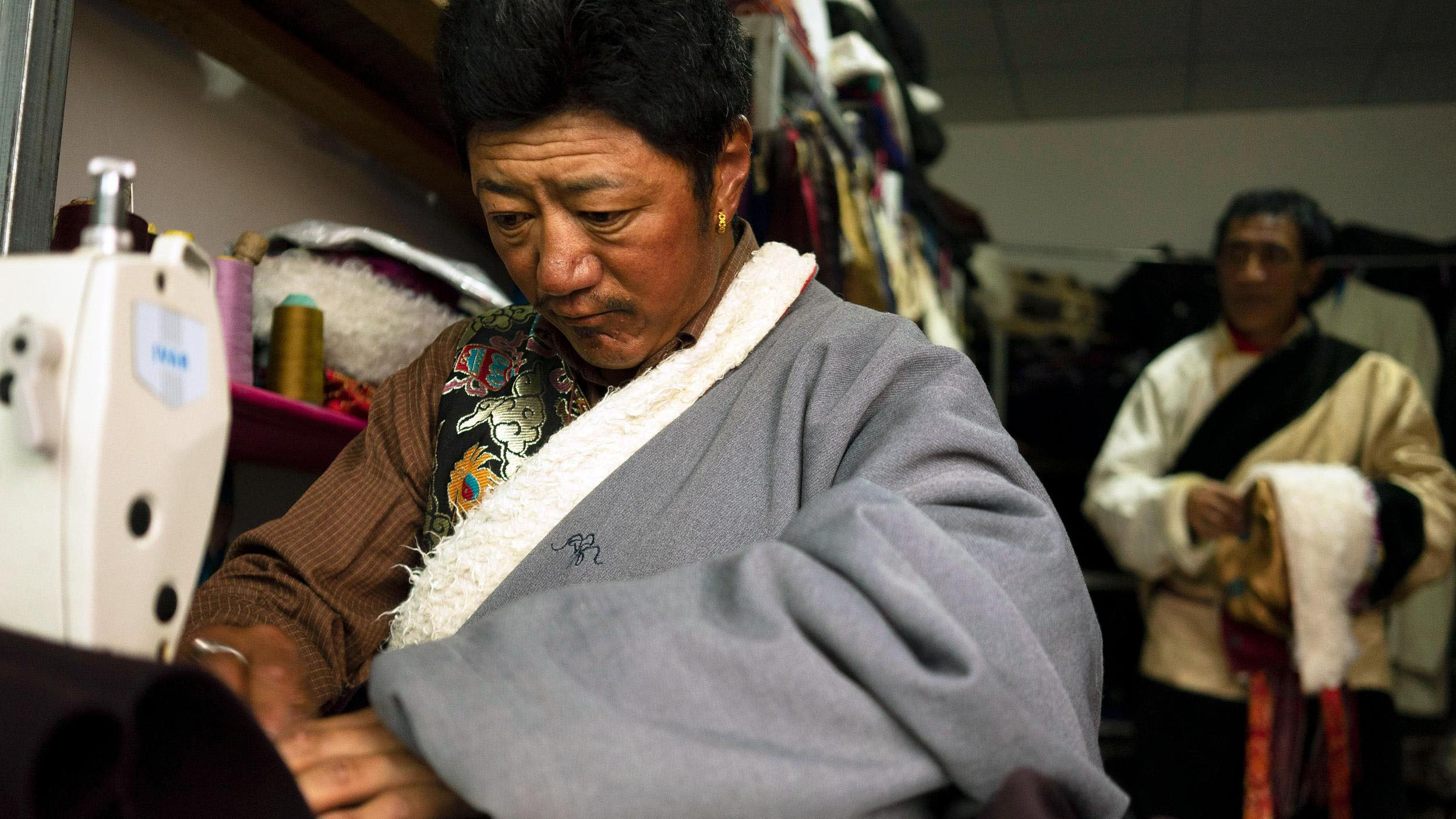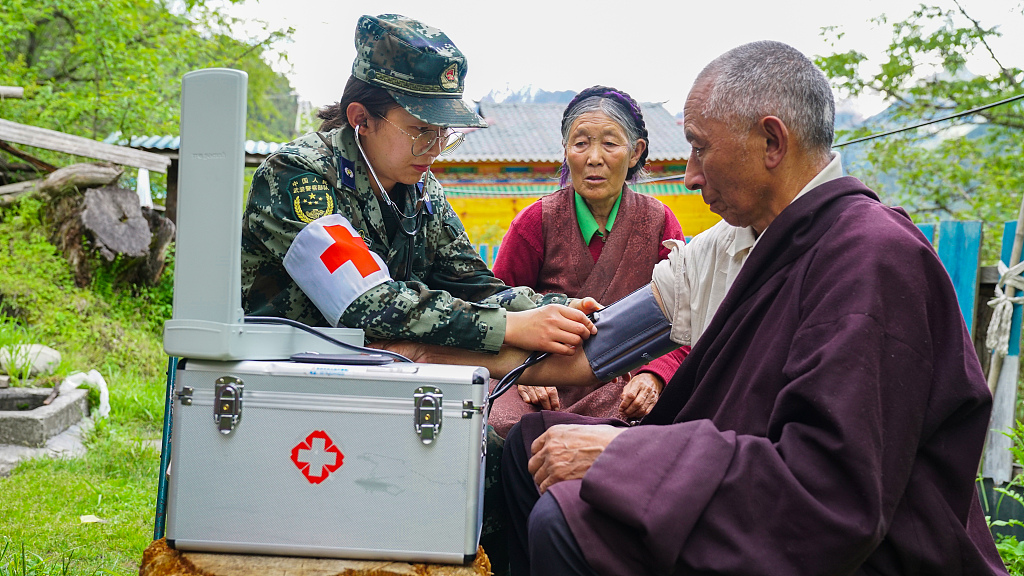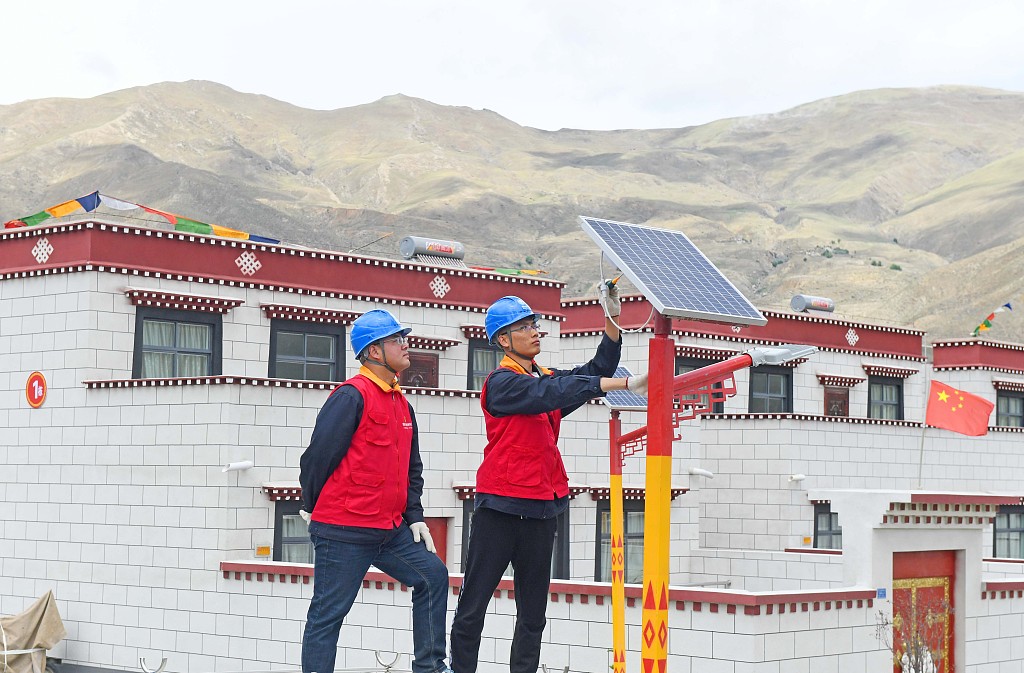01:54

Southwest China's Tibet Autonomous Region is now free of absolute poverty. By the end of 2019, 628,000 people in 74 county-level areas were lifted out of penury, with the annual net income per person surging from 1,499 yuan (about $220.44) in 2015 to 9,328 yuan (about $1,392.78) in 2019.
Also known as the "roof of the world," Tibet's picturesque plateau landscape and rich ethnic culture has attracted many inland visitors in recent decades, but its harsh geographical features significantly contributed to its poverty-related problems with many living in extremely remote mountainous areas in the absence of electricity and running water.
With still months until the next year, the region on Thursday declared victory over absolute poverty. Let's see how the feat was accomplished despite daunting hardships.

An army doctor tends to a patient in Nyingchi, southwest China's Tibet Autonomous Region, June 4, 2020. /VCG
An army doctor tends to a patient in Nyingchi, southwest China's Tibet Autonomous Region, June 4, 2020. /VCG
From bottom to top: Consolidating human resources
The region conjured up a responsibility mechanism consolidating officials at provincial, city, county and township levels. The provincial-level officials conducted in-depth research on impoverished cities and counties, analyzing the causes on a county-by-county basis. They subsequently engineered a 70-page strategy to eliminate poverty based on local conditions.
These officials traveled to the most treacherous terrains in the region, leading investigations, fostering poverty relief programs and supervising the implementation.
What are the institutional designs of China's poverty reduction governance?
Developing characteristic industries
Tibet authorities have vigorously developed highland barley, yak, tourism and construction material industries during the years, injecting a total of 39.89 billion yuan in more than 2,900 poverty alleviation projects since 2016. This helped over 238,000 people shake off extreme poverty and benefited more than 840,000 others.
During the pandemic, 27 counties in the region built e-commerce platforms with online sales reaching more than 200 million yuan. Over 263 kinds of products entered the national poverty alleviation product list, which encouraged consumers to purchase agricultural products. The total sales of poverty alleviation products through e-commerce platforms in Tibet surpassed 150 million yuan.
What is consumption-driven poverty alleviation?
00:44

Relocating pastoralists and farmers
Great efforts were made to move impecunious people living in tough climatic conditions to areas with relatively rich natural resources and better infrastructure. To date, the construction of 965 relocation sites has been completed, and 266,000 people have settled into their new houses.
The relocation is entirely voluntary. Local farmers and herders can choose to work within Tibet or in neighboring or other regions, according to officials. Local residents often express a strong desire to work outside of their hometowns and learn new skills.
A third-party assessment of Tibet's anti-poverty efforts showed that the satisfaction rate among local people in the region was over 99 percent.
"In the beginning of the relocation program, it was hard to persuade some elders, who hold deep affection to their homeland, to leave, and we had to put in a lot of work. For example, we invited them to see new buildings, scope out the location, layout and facilities around the residential complex. At last, they voluntarily moved into their new houses. Currently, we're not worried that people are loath to move, but concerned that some of them who don't meet the criterion also want to move into a new house. To solve that, we still have to do a lot of work," Wu Yingjie, chief of Communist Party of China in Tibet told reporters during a news briefing on Thursday.
Trans-regional job offers help Xinjiang farmers shake off poverty
Sichuan's largest relocation site begins housing distribution

Grid workers from east China's Anhui Province are adjusting the lighting equipment at a relocation site, Qonggyai County, southwest China's Tibet Autonomous Region, June 23, 2020. /VCG
Grid workers from east China's Anhui Province are adjusting the lighting equipment at a relocation site, Qonggyai County, southwest China's Tibet Autonomous Region, June 23, 2020. /VCG
East helps west
Since the mid-1990s, cooperation between China's more developed eastern regions and less developed western regions has invariably been a core tenet of the country's anti-poverty measures, bridging the previously widening gulf between the poor east and the rich west.
Under the east-west pairing-off program, over 313 projects worth 19.52 billion yuan have landed in Tibet, 1,004 medics and 1,676 teachers from inland cities have come forward to assist the region and over 8,000 residents have migrated to eastern provinces for work, 5,000 of which are graduates.
How do companies help alleviate poverty in China?
City in E China provides medical services to poverty-hit areas
Building infrastructure
Improving local infrastructure, including water, electricity, roads, telecommunications and internet, was the at center of these efforts. According to officials, the local government has built and reinforced 17,581 drinking water projects in the region, benefiting more than two million farmers and pastoralists.
Power grid interconnection across the region has also been completed, covering almost all villages.
Additionally, 38,200 kilometers of new roads have been built, connecting all villages. Fiber broadband has been installed in a total of 5, 433 villages, among which 5, 393 villages enjoy 4G network.
Over 80% of China's rural population has safe running water: official

Zegong Highway on the north bank of the Yajiang River in southwest China's Tibet Autonomous Region, November 16, 2019. /VCG
Zegong Highway on the north bank of the Yajiang River in southwest China's Tibet Autonomous Region, November 16, 2019. /VCG
Vocational training and education
The local government has relentlessly promoted compulsory education in the region, providing free tuition, meals and accommodation to students. Those who are under age 15 have been registered to avoid destitution drive them out of school. As of September, all 5,213 dropped-out students have returned to school with the help of local authorities.
Additionally, people from poor families can also enroll in secondary vocational education programs free of cost. So far, over 176,300 people have successfully completed the training, and more than 340, 500 people have found employment thereafter.
'Education is the most fundamental way out of poverty'
Fighting poverty through education: 32-year city-to-city cooperation reduces China's education gap
Social insurance is the bottom line
Tibet has a population of about 3.51 million, which has increased quickly in recent years partly due to the rising birth rate.
Due to cultural reasons, local women often refuse to go to hospitals for delivery, triggering a high rate of infant mortality. In recent years, the local government has intensified its efforts to encourage women to go to hospitals by ensuring specialized maternity care and handing out subsidies for those who give birth in medical facilities.
The national health insurance covers families across the region, preventing people from falling back into poverty due to diseases.
Over 110,000 people in the region have registered in the national minimum subsistence subsidy scheme, under which the annual per capita minimum subsidies for different levels of impoverished groups have increased to 4,713 yuan, 7,070 yuan and 13, 213 yuan respectively.
Facts Tell: Can China realize sustainable poverty alleviation?